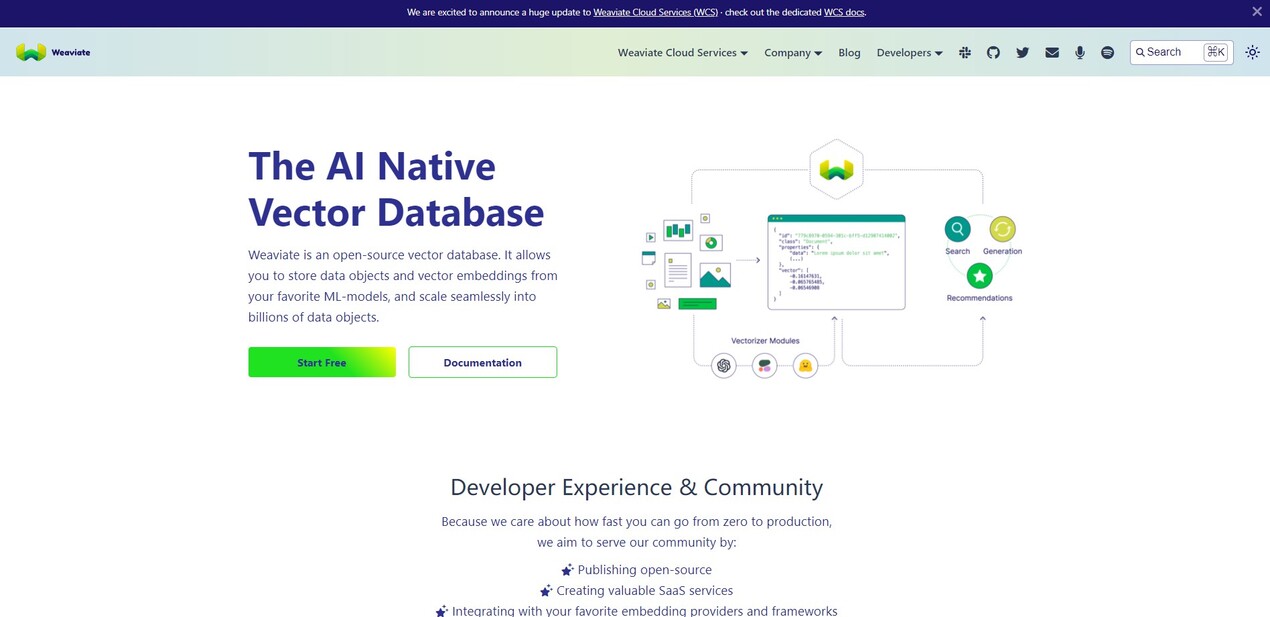
What is Weaviate?
Weaviate is an open-source vector database designed to power a new generation of AI-native applications. It uniquely stores both data objects and their vector representations simultaneously, enabling you to combine lightning-fast vector search with structured filtering for precise data retrieval. Built with developers, data engineers, and data scientists in mind, Weaviate provides the robust foundation needed for intelligent search and AI workflows.
Key Features
Weaviate provides essential capabilities to help you build and scale modern AI applications efficiently:
📦 Combined Vector & Object Storage: Weaviate stores both your data objects and their vector embeddings together. This fundamental architecture allows you to perform semantic vector searches while simultaneously applying traditional structured data filtering on properties, leading to highly accurate and contextual results.
🔍 Hybrid Search: Enhance search experiences by seamlessly merging vector search for conceptual understanding and keyword techniques for precise matching. Hybrid Search delivers more relevant and contextual results across your datasets with reduced query complexity.
🧠 Flexible Vectorization & Modules: Turn your data into searchable vectors using state-of-the-art ML models. Weaviate offers flexibility by allowing you to use built-in models, connect to external services like OpenAI, Cohere, or Hugging Face via a rich module ecosystem, or upload your own pre-vectorized data.
⚡ High Performance: Experience exceptional speed for demanding AI workloads. The core engine is optimized to run 10-NN nearest neighbor searches on millions of objects in milliseconds, ensuring responsive applications even at scale.
🛡️ Production-Ready Foundation: Designed for reliability and scale, Weaviate includes built-in support for scaling, replication, and security (like RBAC). Its cloud-native and distributed architecture makes it suitable for deploying AI applications from rapid prototyping to large-scale production environments.
Use Cases
Leverage Weaviate to build innovative AI applications and enhance existing systems:
Building Trustworthy Generative AI (RAG): Use Weaviate as a reliable knowledge base for Retrieval-Augmented Generation. By storing and retrieving relevant context from your proprietary data, you can ground Large Language Models (LLMs) to provide accurate, domain-specific answers and reduce hallucinations.
Intelligent Search & Recommendation Systems: Implement sophisticated search engines that understand the meaning behind queries and data, or create highly relevant recommendation systems. Combine semantic vector search with structured filtering to find conceptually similar items that also meet specific criteria (e.g., finding similar products within a certain price range).
Fueling Context-Aware AI Agents: Provide AI agents with long-term memory and the ability to retrieve vast amounts of relevant information. Weaviate enables scalable, context-aware agentic workflows that can learn, adapt, and make informed decisions based on your enterprise knowledge base.
Why Choose Weaviate?
Weaviate is purpose-built as an AI-native database, offering distinct advantages for developers and data professionals:
AI-Native Design: Unlike traditional databases adapted for vectors, Weaviate's core design integrates vector storage and processing with object data and includes AI-specific features like out-of-the-box modules for vectorization and integrations with LLMs and AI frameworks.
Flexibility & Openness: As an open-source platform, Weaviate provides transparency and control. Its modular architecture and extensive integrations allow you to choose the models, services, and deployment environments that best fit your needs.
Developer Experience: Weaviate focuses on simplifying AI application development with features like a GraphQL API, clear documentation, quickstart guides, and tooling designed to accelerate your journey from prototype to production.
Conclusion
Weaviate provides the robust, flexible, and high-performance foundation required to build advanced AI-native applications powered by intelligent search and data retrieval. By uniquely combining vector and object storage with production-grade features, extensive integrations, and a supportive community, Weaviate empowers you to bring your innovative AI ideas to life.
Explore how Weaviate can accelerate your AI development journey.






